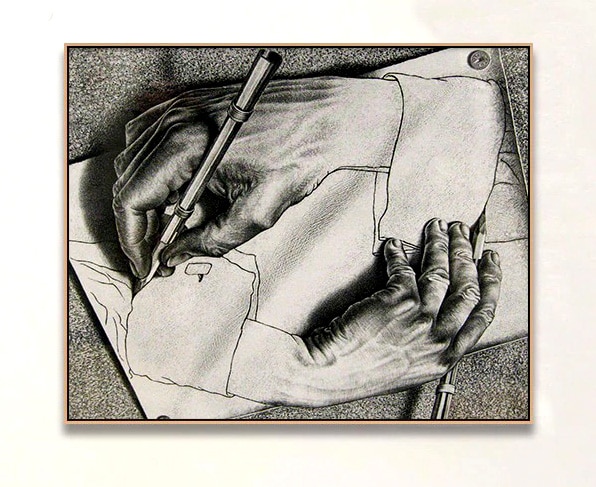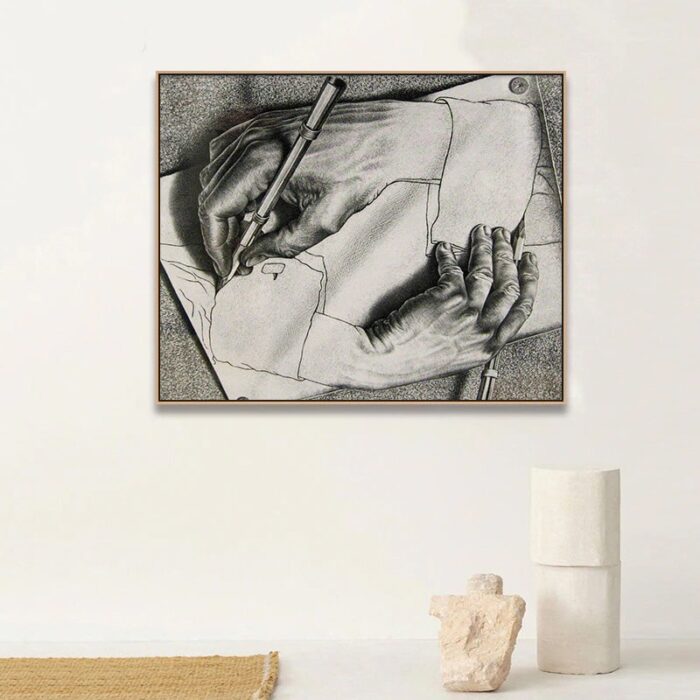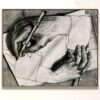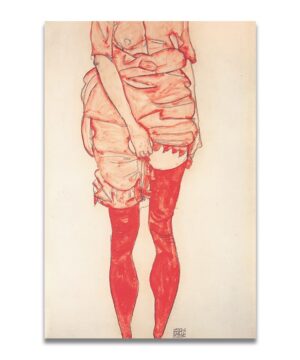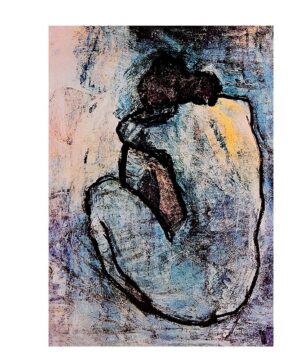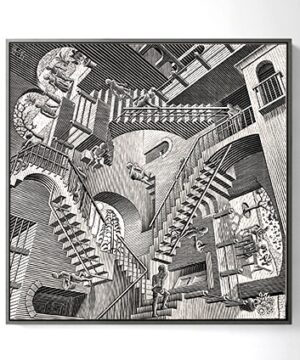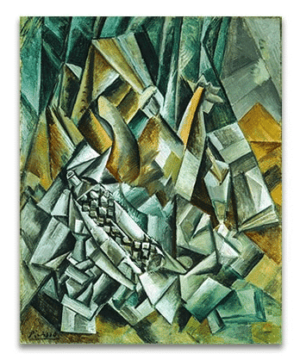Although associated with SurrealismSurrealism was a 20th-century philosophical, literary, and artistic movement seeking to channel the unconscious to access the imaginary. Proponents of Surrealism rejected the notion of understanding life in rational and conventional terms in favour of asserting the value of the unconscious mind, dreams, the strangely beautiful, and the uncanny. André Breton, the leader of a group of poets and artists More and SymbolismSymbolism was a late 19th-century art movement of French, Belgian, and Russian origin. Poets and fine artists were seeking to represent absolute truths using metaphorical images in reaction against realism and naturalism. Content of both images and poetry were suggestive contents to express mystical ideas, emotions, and states of mind. Paul Gauguin, Nave Nave Mahana (1869) The term was coined More due to his fantastical imagery, Maurits Cornelis EscherDutch artist Maurits Cornelis Escher (1898-1972) is internationally appreciated for his graphic art today. He is best known for his woodcuts, mezzotints, and lithographs, featuring mathematical and “impossible” objects, in which he explored symmetry, perspective, infinity, and reflection. Born as the youngest son of a civil engineer, he was a sickly child and had poor grades at school failing second More never saw himself as belonging to any of the art movements of his time. He is best known for his woodcuts, mezzotints, and lithographs, featuring mathematical and “impossible” objects in which he explored symmetry, perspective, infinity, and reflection. With the lithograph “DrawingDrawing is a foundational art form that involves creating images on a surface, typically paper, using tools such as pencils, pens, and charcoal. It is a versatile medium that allows artists to express ideas, emotions, and stories through lines, shapes, and shading. Historical Background • Prehistoric Beginnings: The earliest known drawings date back to prehistoric times, with cave drawings found More Hands”, Escher experimented with the paradoxical system of the “strange loop”, which continuously self-referentially repeats itself with no obvious beginning or end.
Where is the picture “DrawingDrawing is a foundational art form that involves creating images on a surface, typically paper, using tools such as pencils, pens, and charcoal. It is a versatile medium that allows artists to express ideas, emotions, and stories through lines, shapes, and shading. Historical Background • Prehistoric Beginnings: The earliest known drawings date back to prehistoric times, with cave drawings found More Hands” today?
The original print of the lithograph “DrawingDrawing is a foundational art form that involves creating images on a surface, typically paper, using tools such as pencils, pens, and charcoal. It is a versatile medium that allows artists to express ideas, emotions, and stories through lines, shapes, and shading. Historical Background • Prehistoric Beginnings: The earliest known drawings date back to prehistoric times, with cave drawings found More Hands” is part of the Cornelius Van S. Roosevelt Collection today.
What’s in it?
The three-dimensional geometric graphic of “DrawingDrawing is a foundational art form that involves creating images on a surface, typically paper, using tools such as pencils, pens, and charcoal. It is a versatile medium that allows artists to express ideas, emotions, and stories through lines, shapes, and shading. Historical Background • Prehistoric Beginnings: The earliest known drawings date back to prehistoric times, with cave drawings found More Hands” displays the image of two hands, each drawingDrawing is a foundational art form that involves creating images on a surface, typically paper, using tools such as pencils, pens, and charcoal. It is a versatile medium that allows artists to express ideas, emotions, and stories through lines, shapes, and shading. Historical Background • Prehistoric Beginnings: The earliest known drawings date back to prehistoric times, with cave drawings found More the other with a pencil in great precision and realistic skill: An artist’s drawingDrawing is a foundational art form that involves creating images on a surface, typically paper, using tools such as pencils, pens, and charcoal. It is a versatile medium that allows artists to express ideas, emotions, and stories through lines, shapes, and shading. Historical Background • Prehistoric Beginnings: The earliest known drawings date back to prehistoric times, with cave drawings found More paper is fastened to a base with drawingDrawing is a foundational art form that involves creating images on a surface, typically paper, using tools such as pencils, pens, and charcoal. It is a versatile medium that allows artists to express ideas, emotions, and stories through lines, shapes, and shading. Historical Background • Prehistoric Beginnings: The earliest known drawings date back to prehistoric times, with cave drawings found More pins in every corner. While the right hand attempts to finish drawingDrawing is a foundational art form that involves creating images on a surface, typically paper, using tools such as pencils, pens, and charcoal. It is a versatile medium that allows artists to express ideas, emotions, and stories through lines, shapes, and shading. Historical Background • Prehistoric Beginnings: The earliest known drawings date back to prehistoric times, with cave drawings found More the shirt cuff of the left arm, the left tries to complete the identical task of its counterpart. Both arms, wrists, and cuffs remain in the mode of a simple sketch, the hands, however, emerge from the drawingDrawing is a foundational art form that involves creating images on a surface, typically paper, using tools such as pencils, pens, and charcoal. It is a versatile medium that allows artists to express ideas, emotions, and stories through lines, shapes, and shading. Historical Background • Prehistoric Beginnings: The earliest known drawings date back to prehistoric times, with cave drawings found More paper in detail and three-dimensional illusion, adopting a completely different perspective.
What’s the context?
Escher was fascinated by paradoxical recursions, whether he explored them in form such as staircases, waterfalls, and in the self-illustrating hands. In “DrawingDrawing is a foundational art form that involves creating images on a surface, typically paper, using tools such as pencils, pens, and charcoal. It is a versatile medium that allows artists to express ideas, emotions, and stories through lines, shapes, and shading. Historical Background • Prehistoric Beginnings: The earliest known drawings date back to prehistoric times, with cave drawings found More Hands”, he contrasted the two-dimensional flatness of a sheet of paper with the illusion of three-dimensional volume, showcasing the coexistence of space and the flat plane. In a later essay, Escher wrote:
“The artist still has the feeling that moving his pencil over the paper is a kind of magic art. It is not he who determines his shapes; it seems rather that the stupid flat shape at which he painstakingly toils has its own will (or lack of will), that it is this shape which decides or hinders the movement of the drawingDrawing is a foundational art form that involves creating images on a surface, typically paper, using tools such as pencils, pens, and charcoal. It is a versatile medium that allows artists to express ideas, emotions, and stories through lines, shapes, and shading. Historical Background • Prehistoric Beginnings: The earliest known drawings date back to prehistoric times, with cave drawings found More hand, as though the artist were a spiritualist medium.”
Chatter and Prattle
M. C. Escher – Facts:
- Escher worked primarily in the media of lithographs and woodcuts. During his lifetime, he made 448 lithographs, wood engravings, and woodcuts, as well as over 2000 drawings and sketches.
- The artist’s most famous works display images that look convincing but defy logic, such as “Relativity”, “Ascending and Descending”, “Up and Down”, and “Waterfall”, besides “DrawingDrawing is a foundational art form that involves creating images on a surface, typically paper, using tools such as pencils, pens, and charcoal. It is a versatile medium that allows artists to express ideas, emotions, and stories through lines, shapes, and shading. Historical Background • Prehistoric Beginnings: The earliest known drawings date back to prehistoric times, with cave drawings found More Hands”.
- Escher has been widely mistaken for a psychedelic dreamer due to his mind-bending imagery. His work first gained recognition in the 1950s due to the emerging appreciating of two very divers subcultures: hippies and mathematicians. Hippies of the 1960s dubbed the artist “godfather of psychedelic art”, a name that Escher was not fond of. He saw himself much more grounded in reality, and continued focusing on geometry as well as experimenting with the possibilities of the depiction of physical landscape.
Do you want to comment on this text or add information? We would like to hear from you.
Read our posts on Escher:
M.C. Escher Art Work: 19 Fascinating Insights into His Life and Creations
M.C. Escher-Like Pop Culture: Homages to the Master of Illusions
Escher’s Printmaking Secrets: Perfect Your Projects with the Best Lino Print Kit
Recommended Reading:
M. C. Escher (2000): M.C. Escher: The Graphic Work Introduced and Explained By the Artist
Bruno Ernst (1997): The Magic Mirror of M.C. Escher (Taschen Specials) by Bruno Ernst (1997-07-31)
F. H. Bool et al. (1992): M.C. Escher: His Life and Complete Graphic Work (With a Fully Illustrated Catalogue)
J. L. Locher (2013): The Magic of M.C. Escher
This article may contain compensated links. Please read Disclaimer for more info. As an Amazon Associate, I earn from qualifying purchases.

